
Chickens come in a wide variety of breeds, each with many colors and patterns. In fact, about 65 variations of colors and patterns occur among modern-day chickens. Feather and skin color in chickens is directly related to genetics, much like coat color in cats, dogs, and horses.
Some colors are dominant, while others are recessive. Humans, along with all living things, have genes. Genetics is the study of genes and heredity (how genes are passed from parent to offspring and what effect they have).
At least 50 distinct chicken breeds exist, though some organizations claim 500 or more “fancy breeds.” Today, we will go over chicken colors from rarest to most common. We’ll also discuss some really neat feather patterns found in chickens.
Obviously, the rarity of the breed may make the color seem more rare. So, this list will be general regarding chickens as a species, rather than by individual breeds. Although we give examples of which breeds these chicken colors occur in, that doesn’t mean they don’t occur in other breeds. Some of these colors look very similar, but have different names depending on the breed.
With all that said, let’s jump right into the rarest to most common chicken colors!
Lavender: The Rarest Chicken Color
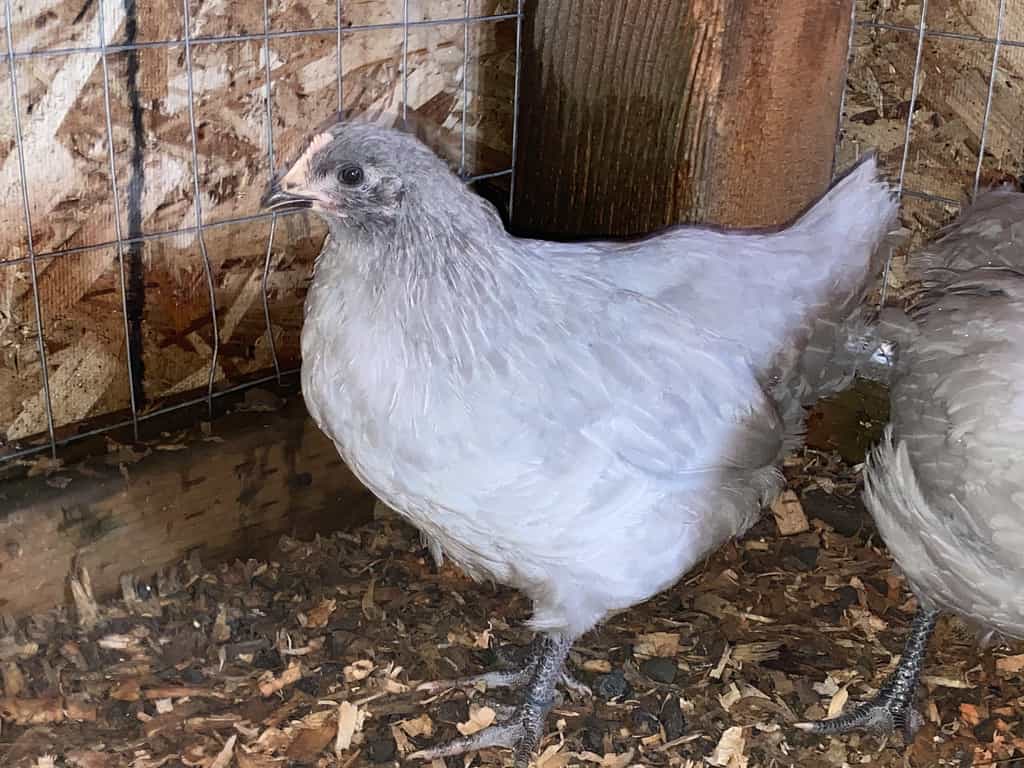
Lavender chickens appear as very light gray but with purplish feet and beaks.
©Storms Photos/iStock via Getty Images
The rarest of all chicken colors, lavender, appears as light gray to off-white. The most defining feature of this color is a purplish hue to the feet and beak. Pekin Bantam and Cochin chickens come in lavender.
Salmon
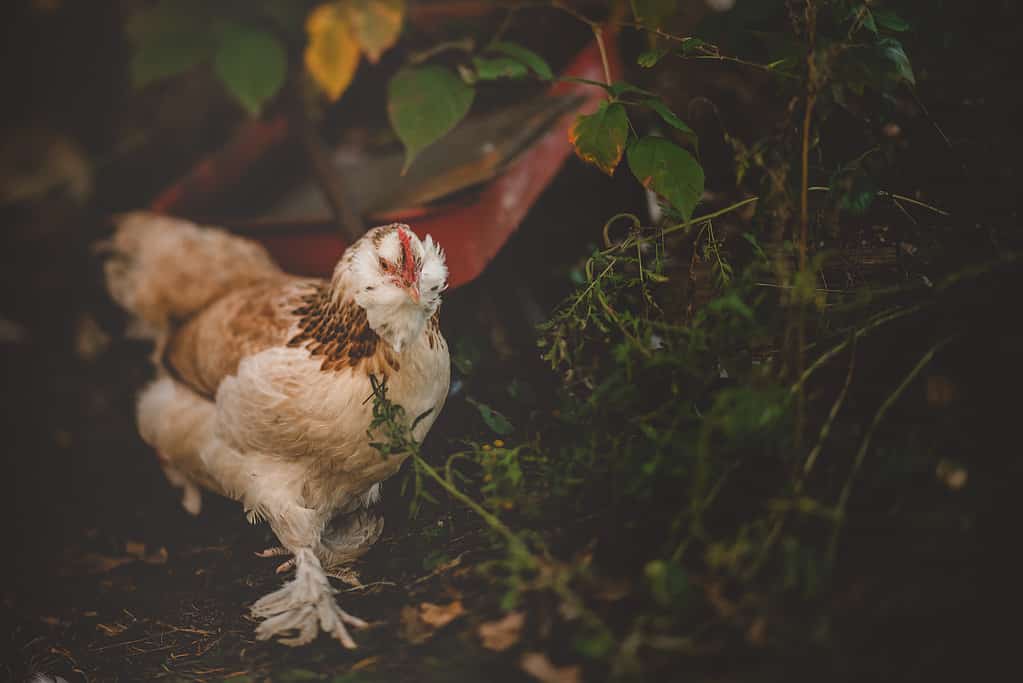
Faverolles chickens are some of the only chickens that come in salmon.
©Cavan Images/iStock via Getty Images
Salmon in chickens consists of feathers the color of cooked salmon. A solid salmon-colored chicken is extremely rare. Most chickens with this color have only patches of colored feathers on a white background. Faverolles chickens are one of very few breeds that come in salmon.
Wheaton
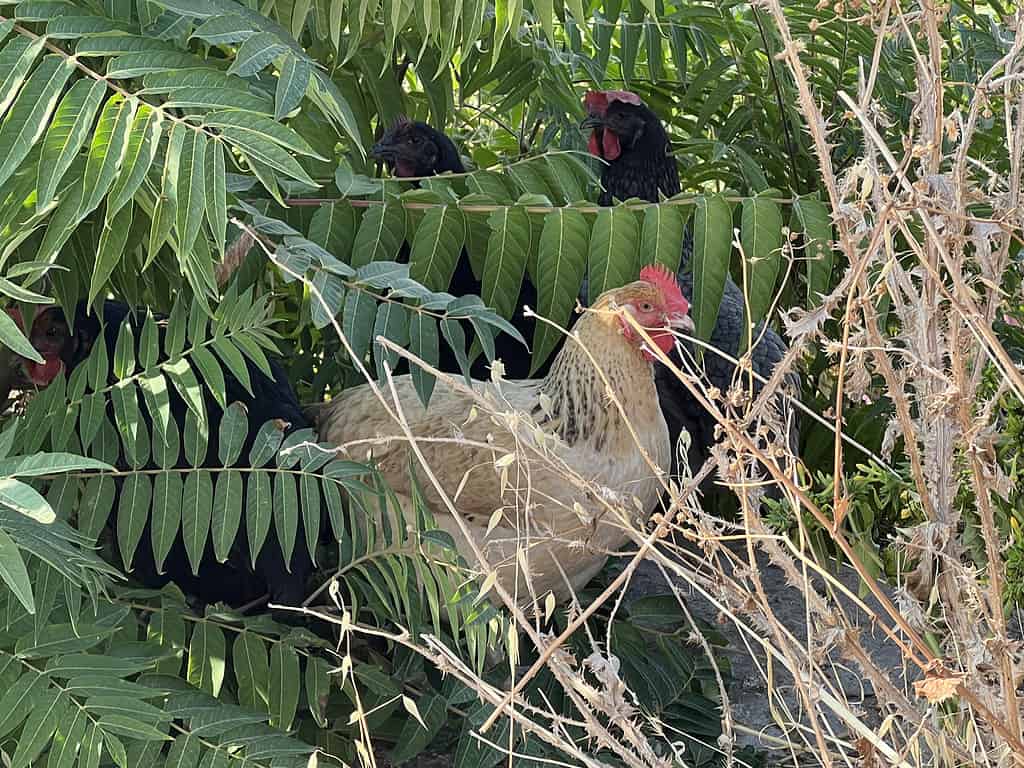
Usually very brightly colored, Marans chickens also come in wheaton.
©Darko Mlinarevic/iStock via Getty Images
Wheaton is an interesting and rare color in chickens. While males tend to be dark gold with amber or orange hues, females are lighter overall. Marans chickens come in wheaton.
Fawn
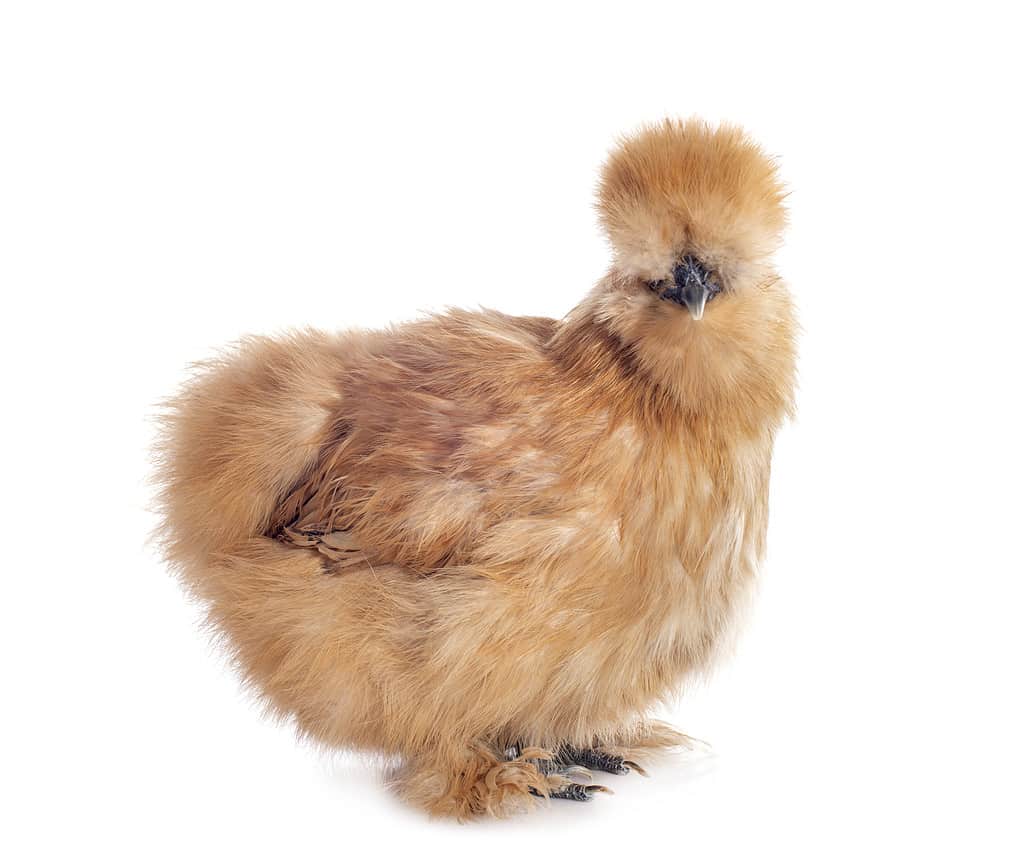
Silkie chickens come in a wide variety of colors, including fawn.
©cynoclub/iStock via Getty Images
Fawn is a very light brown to beige color found in silkie and Wyandotte chickens.
Cinnamon
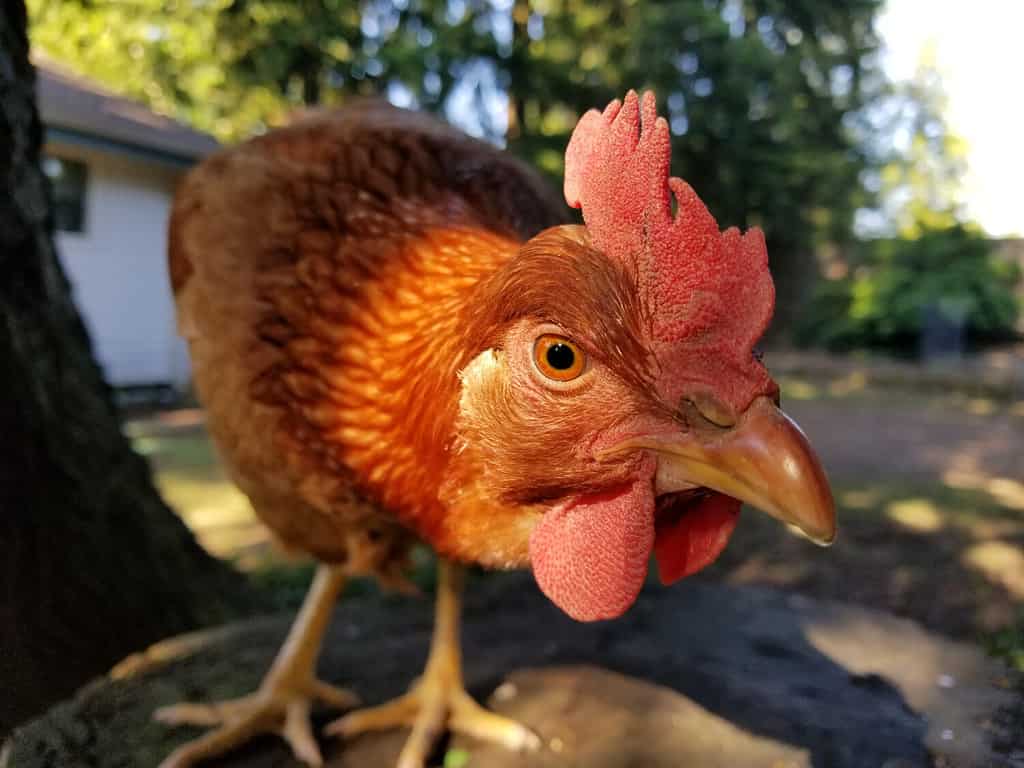
Cinnamon chickens are similar in color to cinnamon sticks.
©Closed Canvas/Shutterstock.com
As the name suggests, this color is a soft reddish-brown, similar to the color of cinnamon sticks. Rhode Island Red and cinnamon queen are two breeds that come in this color.
Bay

Red star (or golden comet) chickens come in bay.
©Tony Campbell/Shutterstock.com
Bay is similar to brown (below) but has more golden tones. Golden comet chickens come in bay coloration. Other names for this breed include ISA brown or red star chickens.
Black: The Most Debatable Chicken Color

Some black chickens are melanistic, like the Ayam Cemani breed.
©Bass001/Shutterstock.com
Black is an interesting color in chickens, which is why we’ve placed it in the middle of the list. The rarity of black-colored chickens is a topic of much debate, as it depends on the specific type of black chicken discussed.
Some chickens are melanistic, while others only have black feathers. Melanistic is a term that refers to animals with higher than normal melanin. Melanistic chickens are black all over. That includes their combs (the fleshy bit on top of the head), wattles (the fleshy bit under the chin), legs, feet, beaks, eyes, and even their flesh, bones, and organs! Other animals with melanistic variants include Bengal cats, leopards, wolves, and even some snake species.
Australorp and Orpington chickens come in black, but only in their feathers. Ayam Cemani, Svart Hona (or Swedish black), and silkie chickens are the only true melanistic chicken breeds.
Black chickens have a green sheen on their feathers. Chicken breeders commonly term this as “beetle green” due to its resemblance to the glossy shell of a beetle.
Brown

Brown Orpington chickens are less popular than their buff cousins.
©Aiselin82/iStock via Getty Images
Appearing light brown to deep chocolate, brown is a pretty generic term when it comes to chicken colors. Some breeds separate brown from chocolate because chocolate requires different genes. Orpington, silkie, and buckeye chickens all have brown variants.
Buff
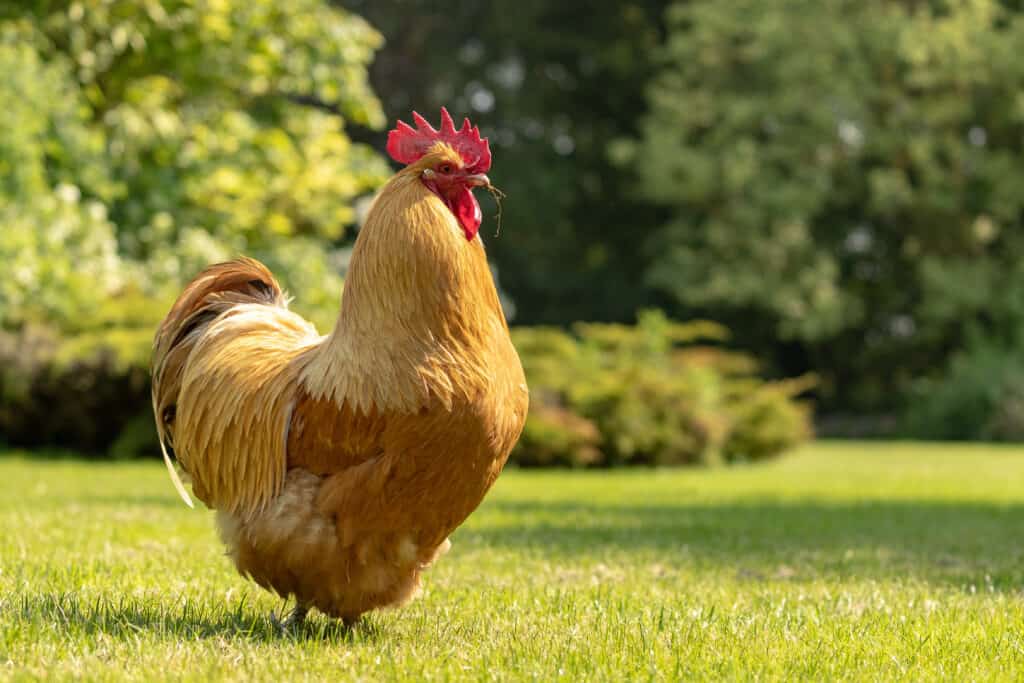
Orpingtons are a breed of chicken that comes in buff coloration.
©LMIMAGES/Shutterstock.com
Orpington and Sussex chickens come in buff, or a golden-orange color. This color comes from the dilution of red. We’ll further discuss dilution when we reach blue chickens.
Chestnut

Easter Egger chickens got their name because the hens lay eggs in a variety of colors.
©Racheal Carpenter/Shutterstock.com
Chestnut is technically a variant of brown. This very dark brown color appears in Rhode Island Red, Ohio buckeye, and Easter Egger breeds. Easter Eggers earned their name from the variety of colored eggs that the hens produce.
Blue
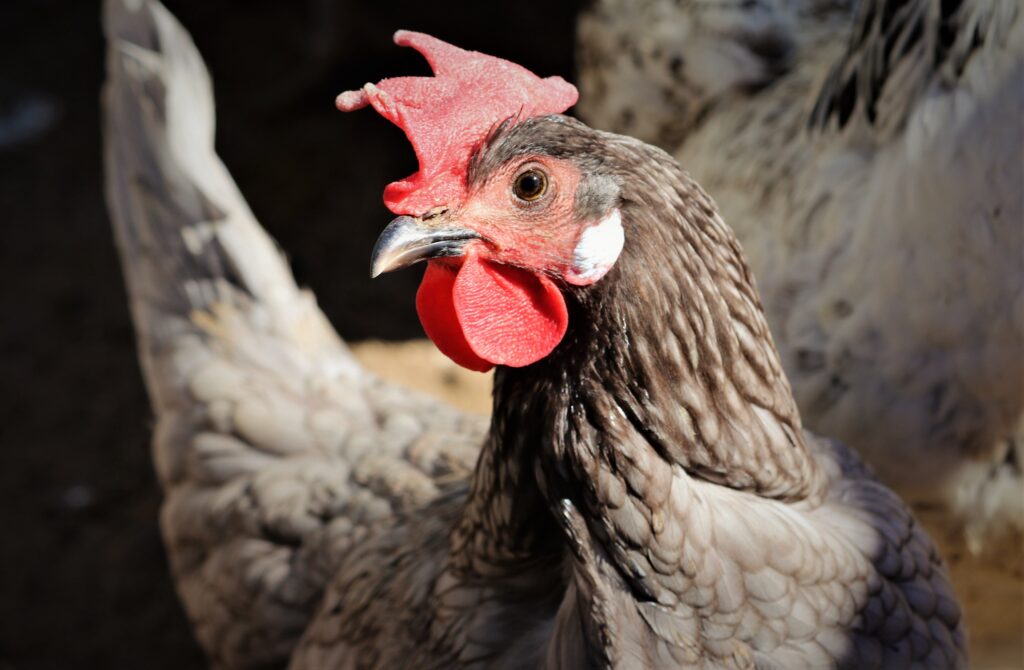
Andalusian chickens come in blue, black, and white.
©Heather Barrett/Shutterstock.com
Blue chickens appear from dark slate gray to lighter smoke gray. This color occurs due to a genetic dilution, where a recessive gene leads to reduced production of melanin, the pigment responsible for coloration. Blue chicken breeds include Wyandotte, silkie, and Andalusian. Blue chickens sometimes have beetle green, too.
Silver
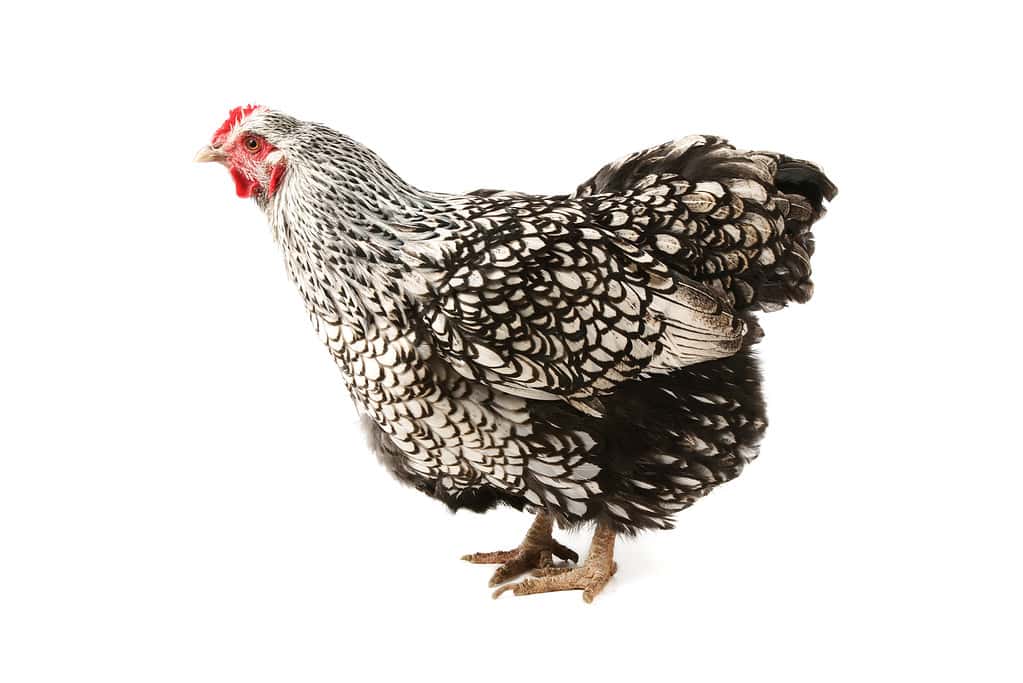
The most common silver chicken is the silver-laced Wyandotte.
©stefan1234/iStock via Getty Images
A silver chicken is technically a chicken without color. This gene removes all melanin from the feathers and when the light hits them, they have a metallic shine. Chickens that come in silver include Wyandotte, Polish, and Sebright bantam.
Red: The Second Most Common Chicken Color
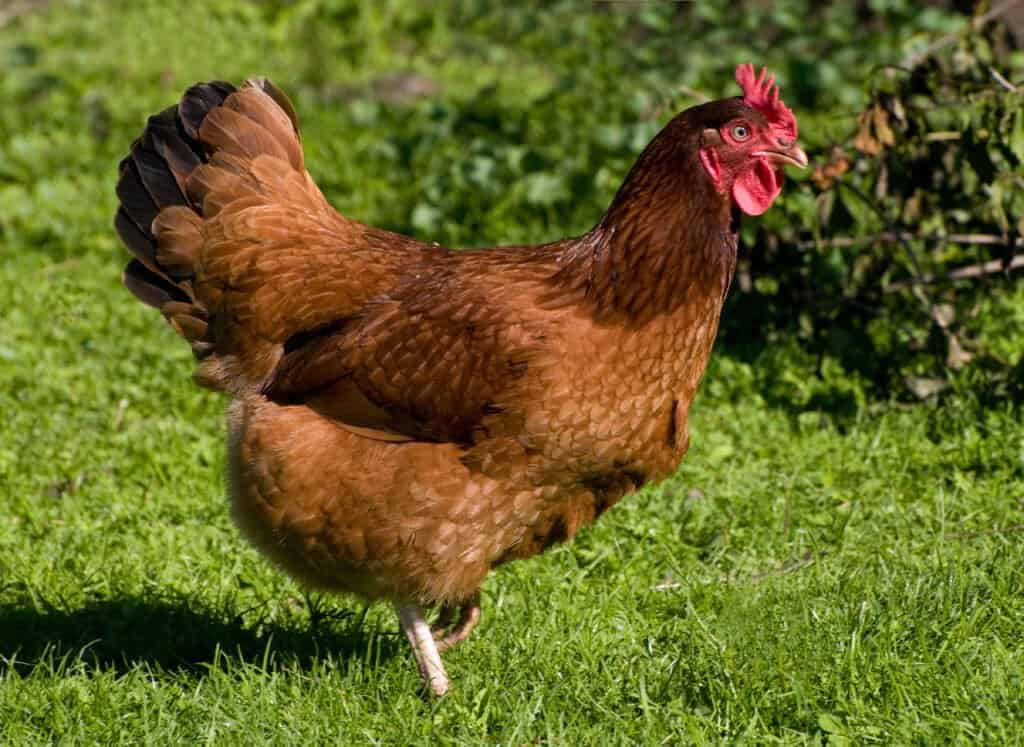
Rhode Island Red chickens most commonly come in red coloration, hence the name.
©Ariene Studio/Shutterstock.com
Red is one of the most common chicken colors. It is also one of the few naturally occurring colors. These chickens are reddish-brown, varying from bright red to dark, nearly maroon red. Rhode Island Red and Sussex chickens are commonly this color.
White: The Most Common Chicken Color

Leghorn chickens are a Mediterranean variety that originated in the Tuscany region of Italy.
©slowmotiongli/Shutterstock.com
The other naturally occurring chicken color is white. As you may guess, these chickens have white feathers. Some white chickens from breeds we haven’t discussed yet include white leghorn and Yokohama chickens.
Patterns: Making Chicken Colors More Exciting
Even more exciting than chicken colors is the variety of patterns they come in! Let’s check out some of the most interesting ones. Many of these patterns combined with different colors, creating chickens that look absolutely incredible!
Birchen Pattern
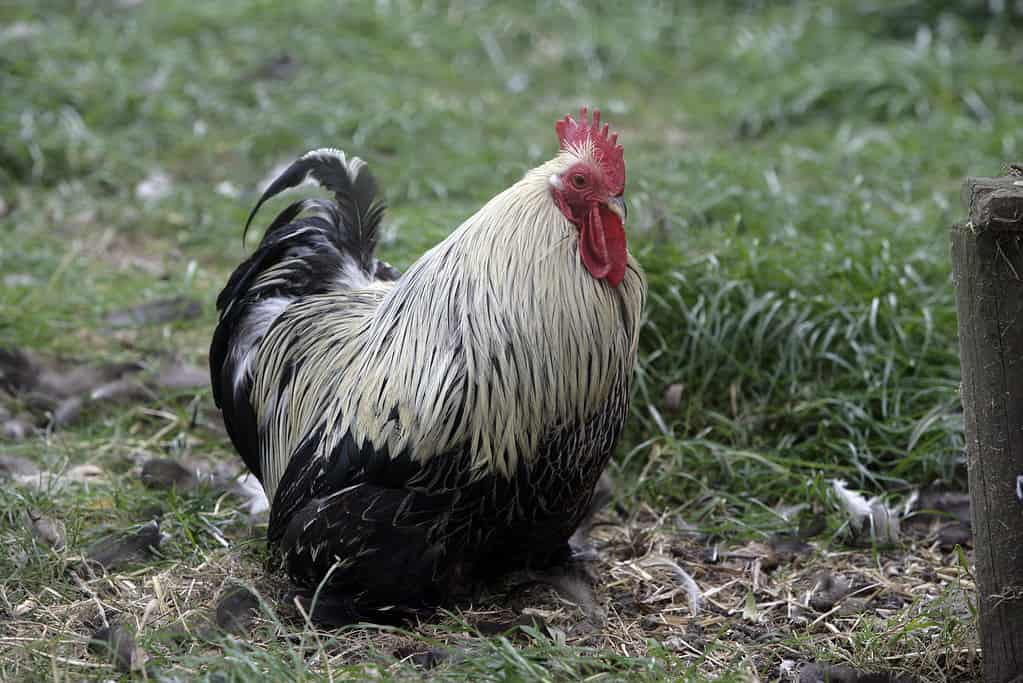
Pekin bantam chickens come in the birchen pattern.
©MikeLane45/iStock via Getty Images
Birchen is a chicken feather pattern characterized by a black body and tail with a silver head. This pattern is found in Marans, Pekin bantam, and Cochin chickens.
Columbian Pattern
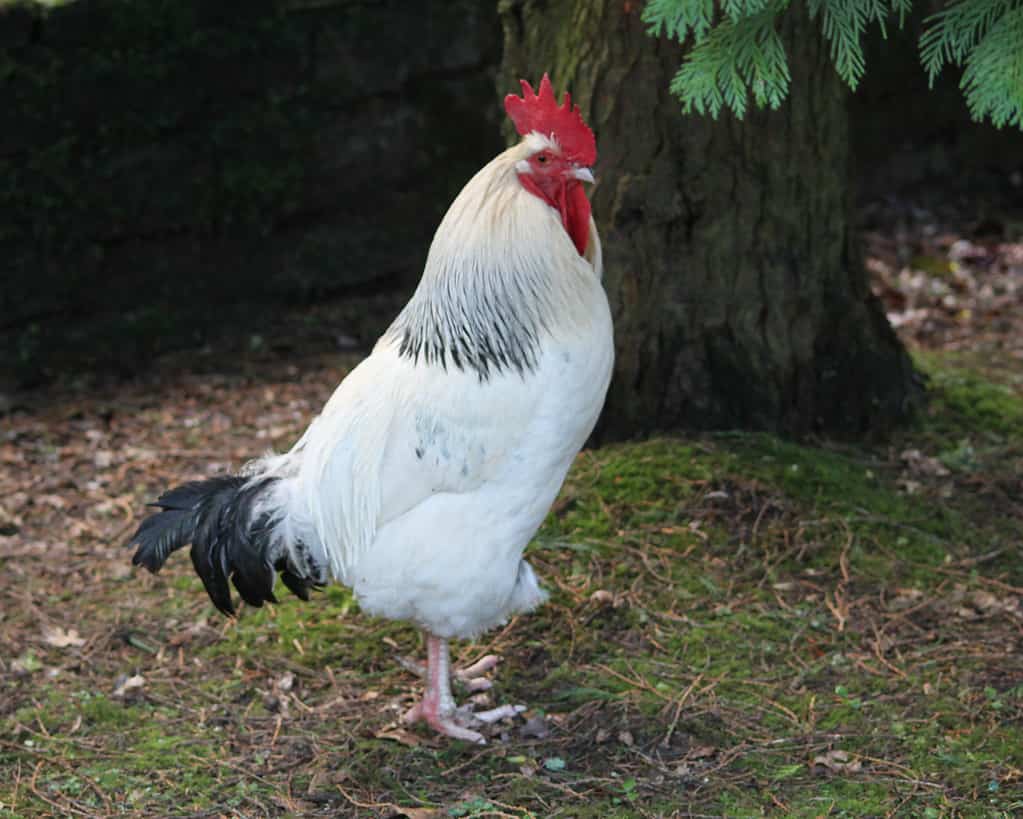
Sussex chickens often come in the Columbian pattern.
©ian600f/iStock via Getty Images
Columbian-patterned chickens are white all over, except for a splash of black feathers around the neck. They also have black tail feathers. This pattern is commonly seen in Sussex chickens.
Millefleur Pattern

Booted Bantam chickens exhibit the millefleur coloration.
©moreimages/Shutterstock.com
The millefleur patterned chicken is red or white with several feathers splashed with silver and surrounded by black. They are quite unique looking! The name literally means a million flowers, which is what their pattern is thought to look like. Polish and booted Bantam chickens come in this pattern.
Laced Pattern
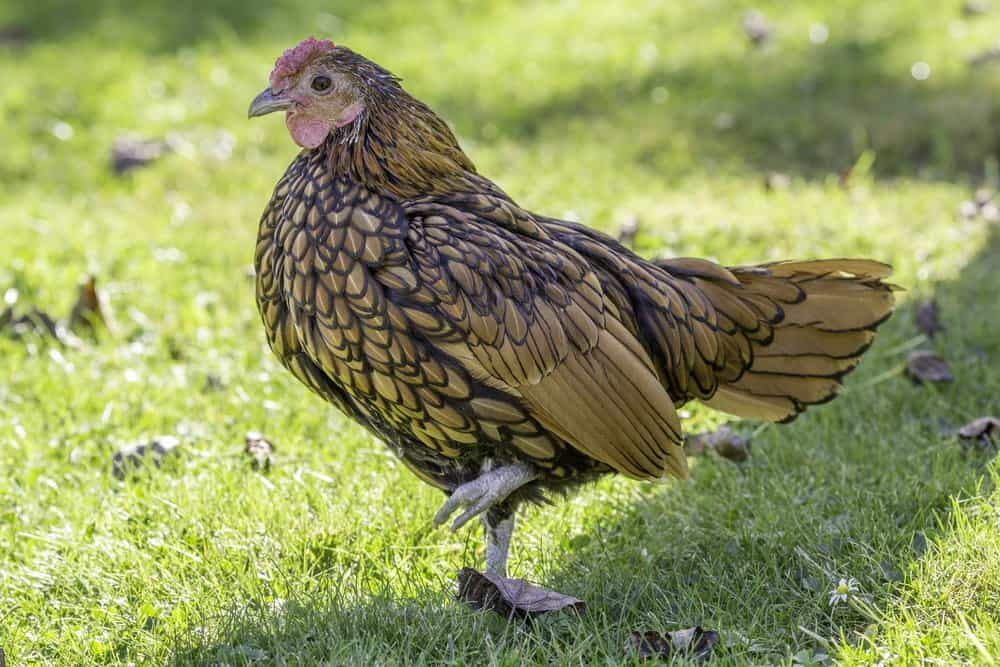
The laced pattern displays as black outlines at the feather edges and occurs in breeds like Sebright bantam chickens, among others.
©Ian Dyball/Shutterstock.com
Lacing is a cool pattern that involves the feathers having a black edge (or lace). This pattern is common in Wyandotte and Sebright bantam chickens. This pattern creates a really beautiful look!
Penciled Pattern
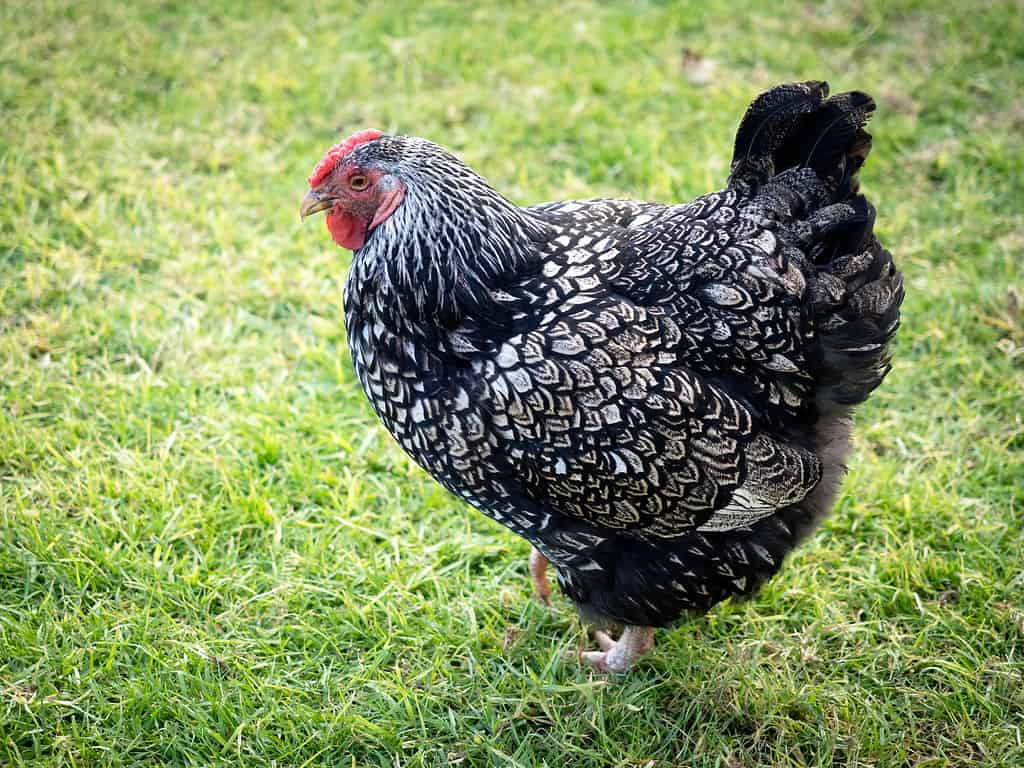
Similar to the laced pattern, the penciled pattern has more lines per feather.
©Wirestock/iStock via Getty Images
The penciled pattern is similar to the laced pattern, but the black lines are much thinner, and there can be multiple lines on each feather. Wyandotte, Hamburg, Plymouth Rock, and Orpington chickens all come in the penciled pattern.
Barred Pattern
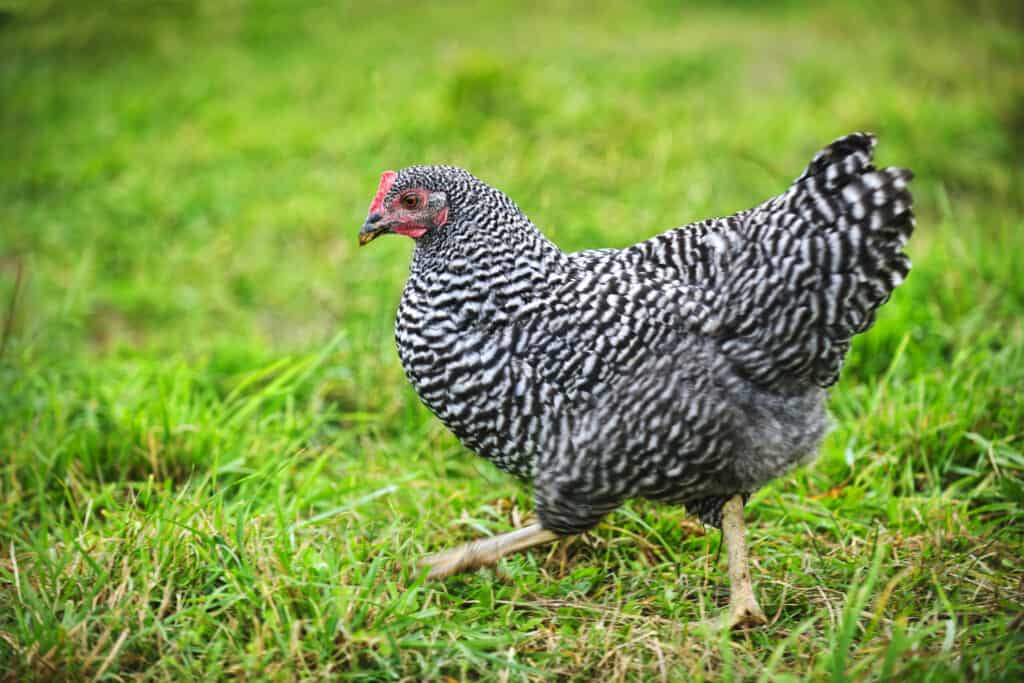
Plymouth rock chickens are a great example of the barred pattern.
©iStock.com/Elenathewise
Barred chickens have alternating bars of color across their feathers. This is usually seen on black chickens with white barring. Plymouth rock chickens display this pattern.
Spangled Pattern
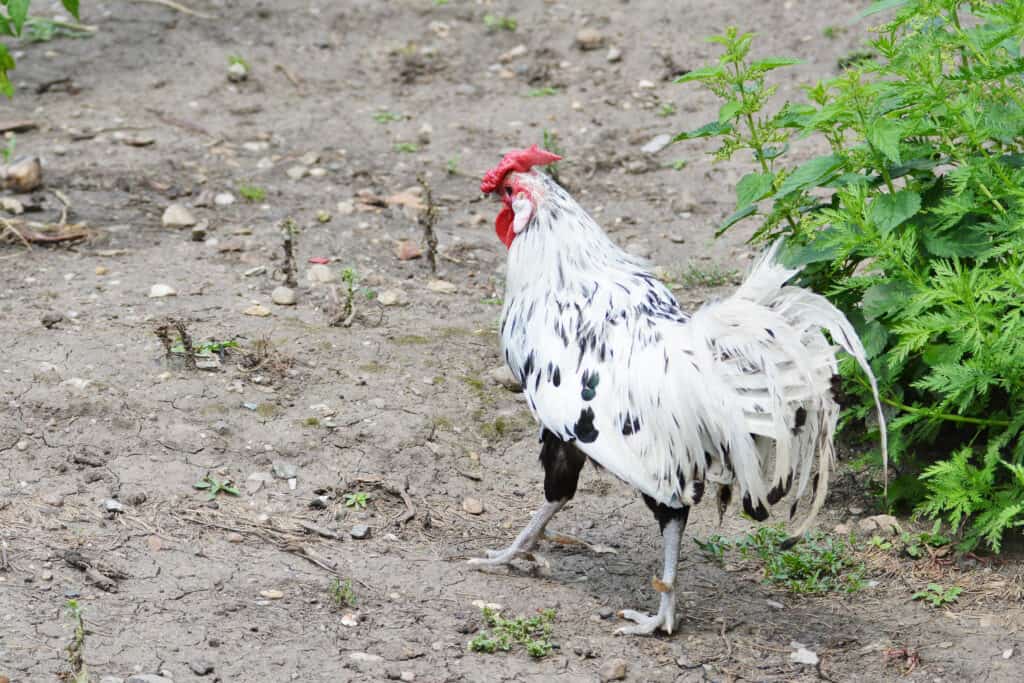
The spangled pattern is common among Hamburg chickens.
©Whiteaster/Shutterstock.com
A chicken with a spangled pattern is most commonly pure white with black tips on each feather. Hamburg chickens most commonly come in spangled patterns.
Mottled Pattern
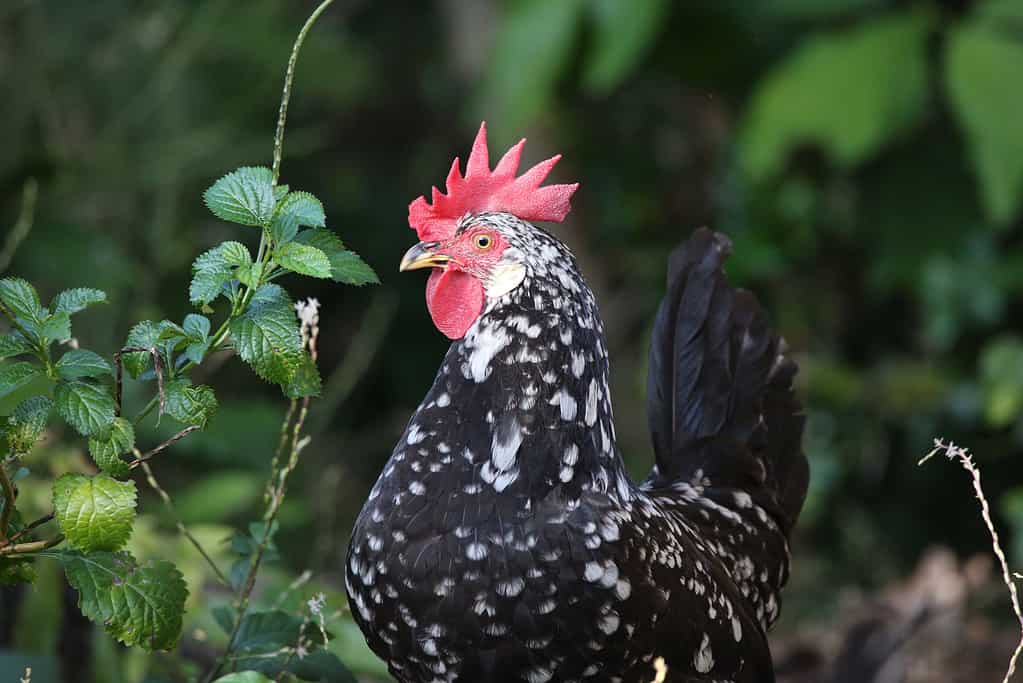
Ancona chickens are the perfect example of the mottled pattern.
©Wirestock/iStock via Getty Images
The opposite of the spangled pattern, the mottled pattern, is when a darkly colored chicken has white-tipped feathers. Ancona and Orpington chickens come in this pattern.
Chicken Colors: Rarest to Most Common Chart
As we have learned, chickens come in a variety of colors and patterns. Here’s a chart to give you an overview of the colors from rarest to most common, including some breeds that come in those colors.
| Rank | Color | Breeds |
|---|---|---|
| 1 | Lavender | Pekin Bantam, Cochin |
| 2 | Salmon | Faverolles |
| 3 | Wheaton | Marans |
| 4 | Fawn | silkie, Wyandotte |
| 5 | Cinnamon | Rhode Island Red, cinnamon queen |
| 6 | Bay | Golden comet |
| 7 | Black | Australorp, Orpington, Ayam Cemani, Svart Hona, silkie |
| 8 | Brown | Orpington, silkie, and buckeye |
| 9 | Buff | Orpington, Sussex |
| 10 | Chestnut | Rhode Island Red, buckeye, and Easter Egger |
| 11 | Blue | Wyandotte, silkie, Andalusian |
| 12 | Silver | Wyandotte, Polish, Sebright |
| 13 | Red | Rhode Island Red, Buckeye, and Easter Egger |
| 14 | White | Sussex, white leghorn, Yokohama |
The photo featured at the top of this post is © TomasSereda/iStock via Getty Images
Thank you for reading! Have some feedback for us? Contact the AZ Animals editorial team.






